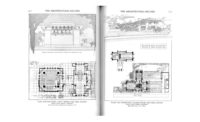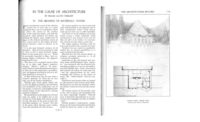And now that word IDEAL.
The IDEAL building? Why, only that building which is all one can imagine as desirable in every way.
And POETRY? Why, the poetry in anything is only the song at the heart of it – and in the nature of it.
Gather together the harmonies that inhere it the nature of something or anything whatsoever, and project those inner harmonies into some tangible “objective” or outward form of human use or understanding, and you will have Poetry. You will have something of the song that aches in the heart of all of us for release.
Any of these Arts called “Fine” are POETIC by nature. And to be poetic, truly, does not mean to escape from life but does mean life raised to intense significance and higher power.
POETRY, therefore, is the great potential need of human kind.
We hunger for POETRY naturally as we do for sunlight, fresh air and fruits, if we are normal human beings.
To be potentially poetic in architecture, then, means – to create a building free in form (we are using the word Romanza) that takes what is harmonious in the nature of existing conditions inside the thing and outside it and with sentiment – (beware of sentimentality) – bring it all out into some visible form that expresses those inner harmonies perfectly, outwardly, whatever the shape it may take.
In this visible shape or form you will see not only what was harmonious in the existing conditions inside and outside and around about the building, but you will also see, in this sentiment of the architect himself – because this ultimate form inevitably would be his sense of BEAUTY living now for you in these known and visible terms of his work.
These words – Poetry, Romans, Ideal – used in proper sense – and I believe I have given them proper expression and interpretation here – are indispensable tools in getting understanding when talking of creation.
Need, really, of a new dimension?
Either a new dimension to think with or a new sense of an old one.
We have heard of the fourth dimension frequently, of late, to meet this need. Why a fourth dimension, when we so little understand the possibilities of what we already use as the three dimensions?
If we make the first two (length and width) into one, as really they are both merely surface, and then add the third (thickness) as the second, thus getting mass, we will have an empty place as third in which to put this new sense as the missing dimension I shall describe. Thus comes in the third dimension about which I have talked a good deal and written somewhat.
Or suppose we arrive at it another way by simply giving spiritual interpretation to the three dimensions we already use. Say length (the first dimension) becomes continuity, width (the second dimension) becomes that breadth of which we speak when we refer to the measure of some great man’s mind or a great prospect. Then thickness (the third dimension) becomes “depth” and we give to that word, “depth,” the meaning we give to it when we speak of the “profound,” the organic, the integral – again we have the third dimension.
We reach the missing dimension either way, but reach it we must.
For it is necessary to find some term that will make it easy to express this missing quality in discussing creation and reaching within for understanding.
But why say fourth dimension when, by properly interpreting the three we already have and by giving them the higher significance which is theirs by nature, we may be spared the confusion of more mere numbers?
This, then, is what I mean by the third dimension. Either an interpretation of the physical third, an interpretation that signifies this quality of “at-one-ness” or integral nature in anything or everything. Or, arrive at it by naming the three dimensions as now used as actually but two, adding the third as a new concept of organic-integrity, or more properly speaking, as that quality that makes anything of the thing and never on it.
Thus came the new conception of architecture as interior-space finding utilization and enclosure as its “members” – as architecture. The within is thus made concrete realization in form.
This is the integral concept of building for which I have pleaded, am still pleading and will continue to plead, instead of the earlier one – beautiful but less great – in which a block of building material was sculptured, punctured, and ornamented into architecture.
In this matter of supplying the needed term as the third dimension I may be found guilty of making a language of my own to fit my necessity.
Perhaps that is true – although it seems obvious enough to me that the quality lacking in the thought of our modern world where creation is concerned, is simply expressed in this way. I should be thankful for a better more evident expression of this subjective element.
If I could find it I should be among the first to use it.
Until then I can only write and speak of this essence of all creative endeavor, objectively, as the third dimension. And here in this matter will be found the essential difference between what is only modern and what is truly new.
The pictorial age in which we live will no longer be satisfied to have the picture continue without this interior significance expressed in integral form. Two dimensions have characterized the work of the past centuries and two-dimension thought and work is still modern, it seems. Is it too much to hope that the coming century will be one in which this element of the third dimension – this demand for organic significance – will characterize all the pictures that go to make up the main picture, which will be then tremendous with integrity and pregnant with new beauty?
Now, there are certain things as hard as nails, as pointed as tacks, as flat as a barn door that go to make up the technique of creation in this deepened, enlivened, more potential sense.
Since we now have materials in our hands to work with as elements, it is method that I now want to write about, believing that if I can make even the beginning of the matter of making true, significant buildings a little more clear, I shall have rendered real service. I would much rather build than write about building, but when I am not building, I will write about building – or the significance of those buildings I have already built.








Post a comment to this article
Report Abusive Comment